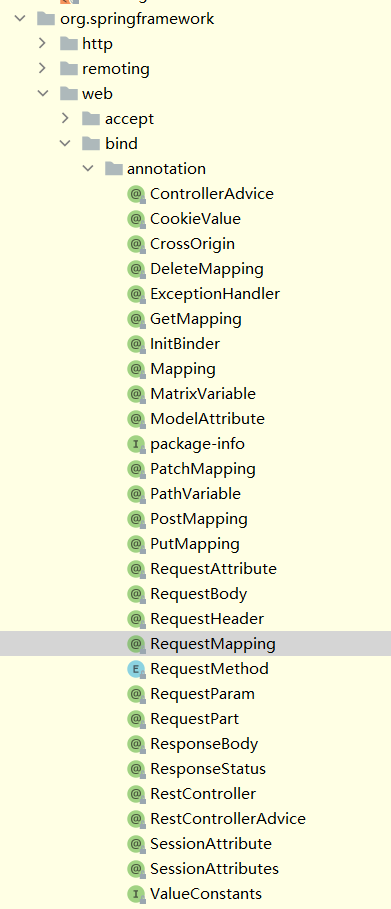添加依赖
<dependency><groupId>org.springframework.boot</groupId><artifactId>spring-boot-starter-web</artifactId></dependency>本文依赖SpringBoot版本信息:<parent><groupId>org.springframework.boot</groupId><artifactId>spring-boot-starter-parent</artifactId><version>2.5.0</version><relativePath/> <!-- lookup parent from repository --></parent>
各种响应
/*** HTTP的所有请求方式: GET, POST, HEAD, OPTIONS, PUT, PATCH, DELETE, TRACE.** @param request 注入* @return 返回字符串*/@RequestMapping("all")public String all(HttpServletRequest request) {log.info("request:{}", JSONUtil.toJsonStr(request));return "all";}@Data@Builder //支持构建者模式public static class R<T> implements Serializable {protected Integer code;protected String msg;protected T data;/*** 响应状态码*/interface Code {int SUCCESS_CODE = 1;int FAIL_CODE = 0;}/*** 响应状态码*/interface Message {String SUCCESS_MESSAGE = "成功";String FAIL_MESSAGE = "失败";}public static <T> R<T> ok() {return new R<>(Code.SUCCESS_CODE, Message.SUCCESS_MESSAGE, null);}}/*** 响应自定义Bean** @return R* @see R*/@RequestMapping("returnR")public R<String> returnR() {log.warn("returnR");return R.ok();}/*** 响应ResponseEntity** @return ResponseEntity* @see ResponseEntity*/@RequestMapping("returnResponseEntity")public ResponseEntity<String> returnResponseEntity() {log.warn("returnResponseEntity");return ResponseEntity.ok("SUCCESS");}/*** 响应自定义ResponseEntity** @return ResponseEntity* @see ResponseEntity*/@RequestMapping("returnResponseEntityHttpStatus")public ResponseEntity<String> returnResponseEntityHttpStatus() {log.warn("returnResponseEntityHttpStatus");return ResponseEntity.status(HttpStatus.BAD_REQUEST)//400.build();}/*** 注解实现响应自定义HTTP状态码** @return ResponseEntity*/@ResponseStatus(HttpStatus.BAD_REQUEST)@RequestMapping("returnResponseStatus")public String returnResponseStatus() {log.warn("returnResponseStatus");return "returnResponseStatus";}
关于自定义响应对象,示例如下:
package com.initit.sbweb.controller;import cn.hutool.db.PageResult;import com.baomidou.mybatisplus.core.metadata.IPage;import com.fasterxml.jackson.annotation.JsonFormat;import io.swagger.annotations.ApiModel;import io.swagger.annotations.ApiModelProperty;import lombok.AllArgsConstructor;import lombok.Builder;import lombok.Data;import lombok.NoArgsConstructor;import java.io.Serializable;import java.time.LocalDateTime;/*** Result* 统一响应解构*/@Data@AllArgsConstructor@NoArgsConstructor@Builder //支持构建者模式@ApiModel(value = "R对象", description = "统一响应对象")public class R<T> implements Serializable {@ApiModelProperty(value = "状态码 0失败 1成功", required = true)protected Integer code;@ApiModelProperty(value = "提示信息")protected String msg;@ApiModelProperty(value = "数据")protected T data;@ApiModelProperty(value = "服务器响应时间 yyyy-MM-dd HH:mm:ss GMT+8", required = true)@JsonFormat(pattern = "yyyy-MM-dd HH:mm:ss", timezone = "GMT+8")protected LocalDateTime responseTime = LocalDateTime.now();/*** 响应状态码*/interface Code {int SUCCESS_CODE = 1;int FAIL_CODE = 0;}/*** 响应状态码*/interface Message {String SUCCESS_MESSAGE = "成功";String FAIL_MESSAGE = "失败";}//构造函数private R(Integer code, String msg, T data) {this.code = code;this.msg = msg;this.data = data;}//----------- 封装常用方法-----------------public static <T> R<T> result(Integer code, String message, T data) {return new R<T>(code, message, data);}/*** 封装特有的boolean类型* 根据boolean类型自动封装返回类型** @param result 结果* @return R*/public static R<Boolean> result(Boolean result) {if (result) {return ok();} else {return fail();}}public static <T> R<T> ok() {return result(Code.SUCCESS_CODE, Message.SUCCESS_MESSAGE, null);}public static <T> R<T> ok(T data) {return result(Code.SUCCESS_CODE, Message.SUCCESS_MESSAGE, data);}public static <T> R<T> ok(String message, T data) {return result(Code.SUCCESS_CODE, message, data);}public static <T> R<T> fail() {return result(Code.FAIL_CODE, Message.FAIL_MESSAGE, null);}public static <T> R<T> fail(T data) {return result(Code.FAIL_CODE, Message.FAIL_MESSAGE, data);}public static <T> R<T> fail(String message, T data) {return result(Code.FAIL_CODE, message, data);}//支持各种分页框架 需要引入Mybatis-Plus框架// public static <T> R<PageResult<T>> ok(IPage<T> page) {// return result(Code.SUCCESS_CODE, Message.SUCCESS_MESSAGE, PageResult.page(page));// }public static <T> R<T> okMsg(String msg) {return R.ok(msg, null);}public static <T> R<T> failMsg(String msg) {return R.fail(msg, null);}}
HTTP各种请求方式
/*** GET请求** @param str url变量,字符串类型参数* @param num url变量, 数字类型参数* @param param1 path参数1* @param param3 path参数2,测试别名* @return 返回字符串*/@GetMapping("get/{param1}/{param2}/test")public String get(String str,Long num,@PathVariable String param1,@PathVariable("param2") String param3) {log.warn("str:{},num:{},param1:{},param2:{}", str, num, param1, param3);return "get";}/*** POST请求,地址变量** @param str url变量,字符串类型参数* @param num url变量, 数字类型参数* @param pathVariable path变量* @return 返回字符串*/@PostMapping("postPathVariable/{pathVariable}")public String postPathVariable(String str,Long num,@PathVariable String pathVariable) {log.warn("str:{},num:{}", str, num);log.warn("pathVariable:{}", pathVariable);return "postPathVariable";}/*** POST请求,body转为JSON对象** @param map json字符串转为map* @param request 请求对象* @return 返回字符串*/@PostMapping("postRequestBodyJson")public String postRequestBodyJson(@RequestBody Map<String, Object> map,HttpServletRequest request) {log.warn("map:{}", JSONUtil.toJsonStr(map));log.warn(request.getRequestURI());return "postRequestBodyJson";}/*** POST请求,body转为字符串** @param txt 字符串请求,使用js/xml/html等* @param request 请求对象* @return 返回字符串*/@PostMapping("postRequestBodyStr")public String postRequestBodyStr(@RequestBody String txt,HttpServletRequest request) {log.warn("txt:{}", txt);log.warn(request.getRequestURI() + " " + request.getContentType());return "postRequestBodyStr";}/*** POST 表单提交** @param str 表单数据,文本类型* @param file 表单数据,文件类型* @return 返回字符串类型*/@PostMapping("postFormData")public String postFormData(String str,MultipartFile file) {log.warn("str:{}", str);log.warn("file:{}--{}--{}--{}--{}",JSONUtil.toJsonStr(file), file.getOriginalFilename(), file.getName(), file.getSize(), file.getContentType());return "postFormData";}/*** POST请求,多文件上传** @param files 多个文件* @return 返回字符串*/@PostMapping("postFiles")public String postFiles(List<MultipartFile> files) {log.warn("files:{}", files.size());for (MultipartFile file : files) {log.warn("file:{}--{}--{}--{}--{}",JSONUtil.toJsonStr(file), file.getOriginalFilename(), file.getName(), file.getSize(), file.getContentType());}return "postFiles";}/*** DELETE请求** @param str url参数,字符串类型* @param num url参数,数字类型* @param pathVariable path参数* @return 返回字符串*/@DeleteMapping("delete/{pathVariable}")public String delete(String str,Long num,@PathVariable String pathVariable) {log.warn("str:{},num:{}", str, num);log.warn("pathVariable:{}", pathVariable);return "delete";}/*** PUT请求** @param str url参数,字符串类型* @param num url参数,数字类型* @param pathVariable path参数* @return 返回字符串*/@PutMapping("put/{pathVariable}")public String put(String str,Long num,@PathVariable String pathVariable) {log.warn("str:{},num:{}", str, num);log.warn("pathVariable:{}", pathVariable);return "put";}/*** PATH请求** @return 返回字符串*/@PatchMapping("patch")public String put() {log.warn("patch");return "patch";}
请求头
/*** 请求头示例** @param str 请求头数据,字符串类型,测试别名* @param num 请求头数据,数字类型* @return 字符串类型*/@GetMapping("requestHeader")public String requestHeader(@RequestHeader("headerStr") String str, @RequestHeader Integer num) {log.warn("str:{},num:{}", str, num);return "requestHeader";}/*** 请求头示例,自定义模式获取** @param request 请求对象* @return 字符串类型*/@GetMapping("requestHeaderRequest")public String requestHeaderRequest(HttpServletRequest request) {String str = request.getHeader("str");String num = request.getHeader("num");log.warn("str:{},num:{}", str, num);return "requestHeaderRequest";}
Cookies
/*** 设置cookie** @param response 响应对象* @return 字符串类型*/@GetMapping("setCookies")public String setCookies(HttpServletResponse response) {Cookie cookie = new Cookie("cookieStr", "test");//设置过期时间 7天过期cookie.setMaxAge(7 * 24 * 60 * 60);//Https 安全cookie 该Cookie将无法在Http连接中传输,只能是Https连接中传输// cookie.setSecure(true);response.addCookie(cookie);log.warn("setCookies");return "setCookies";}/*** 获取cookie** @param request 请求对象* @return 字符串类型*/@GetMapping("getCookiesRequest")public String getCookiesRequest(HttpServletRequest request) {Cookie[] cookies = request.getCookies();log.warn("cookies:{}", cookies.length);for (Cookie cookie : cookies) {log.warn("cookie:{}", cookie);}return "getCookiesRequest";}/*** 获取cookie** @param str cookie数据,字符串类型,测试别名* @param num cookie数据,数字类型* @return 返回字符串类型*/@GetMapping("getCookies")public String getCookies(@CookieValue(name = "cookieStr", defaultValue = "默认数据") String str, Integer num) {log.warn("str:{},num:{}", str, num);return "getCookies";}
Session
/*** 设置Session** @param request 请求对象* @return 返回字符串*/@GetMapping("setSession")public String setSession(HttpServletRequest request) {HttpSession session = request.getSession();session.setAttribute("sessionStr", "test");session.setAttribute("num", 123);//设置过期时间session.setMaxInactiveInterval(30 * 60);log.warn("setSession:{}", session);return "setSession";}/*** 获取Session** @param request 请求对象* @return 返回字符串*/@GetMapping("getSession")public String getSession(HttpServletRequest request) {HttpSession session = request.getSession();Object sessionStr = session.getAttribute("sessionStr");log.warn("sessionStr:{}", sessionStr);log.warn("getSession:{}", session);return "getSession";}/*** 获取Session,使用@SessionAttribute注解** @param str session数据,字符串类型,别名测试* @return 返回字符串类型*/@GetMapping("getSessionSessionAttribute")public String getSessionSessionAttribute(@SessionAttribute("sessionStr") String str) {log.warn("str:{}", str);return "getSessionSessionAttribute";}//@SessionAttributes({"sessionStr", "num"})@SessionAttributespublic class WebController {/*** 获取Session,使用@SessionAttributes注解** @param str session数据,字符串类型,别名测试* @param num session数据,数字类型* @return 返回字符串类型* <p>* 注解@SessionAttributes抓取域对象分为两步;* 1. 在类上添加注解@SessionAttributes;* 2. 在方法的参数中通过@ModelAttribute获取域对象;*/@GetMapping("getSessionSessionAttributes")public String getSessionSessionAttributes(@ModelAttribute("sessionStr") String str, @ModelAttribute Integer num) {log.warn("str:{},num:{}", str, num);return "getSessionSessionAttributes";}


